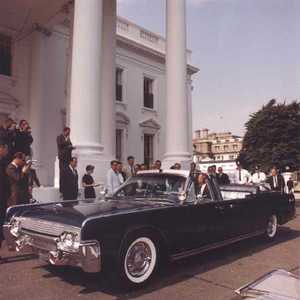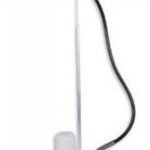The first government-owned car for use by a President of the United States was a white Stanley Steamer that Theodore Roosevelt delighted in taking the wheel of himself. It was open, had no armor, no bulletproof glass, or other safety amenities, and was truly a ‘stock’ car. It didn’t even have a Secret Service code name.
The Midnight Blue 1961 Lincoln that President John F. Kennedy was assassinated in on November 22, 1963 in Dallas, Texas, carried the Secret Service code name “SS 100X.” It had been delivered to The White House on June 14, 1961.
In 1963 the car’s grille was replaced by one from a 1962 model for aesthetic reasons, and ‘sombrero’-style wheel covers like those of the 1957 Lincoln Premiere were added. Trunk lid grab handles for Secret Service agents were also affixed. The undistinguished District of Columbia license plates on SS 100X had the simple two-letter, three number designation: GG 300.
During his time in office JFK used the car on various overseas and domestic trips. When the armored limousine needed to be transported in the air, it was typically flown in by a US Air Force cargo plane that arrived at the location before the big Boeing 707 known as Air Force 1. For moving long distances on the ground, the Secret Service had a large trailer, once used by Ringling Brothers for circus animals, to move the 21 foot leviathan from place to place.
Even before Air Force One had rolled to a stop in the appropriately designated space at Love Field in Dallas, Texas, the earphones worn by members of the Secret Service’s detail were alive with chatter. On the aircraft Roy Kellerman, the senior agent attached to the President, queried Agent Bill Greer on the ground as to the status of “SS 100X.” Greer replied that the vehicle was in position and waiting for “Lancer”, the code name for President Kennedy, and his party. Jacqueline Kennedy’s code name was “Lace.” In the motorcade, Kellerman would be in the front seat, the so-called “riding shotgun” seat, next to Greer.
It was bright, sunny and 76 degrees in Dallas when Agent Greer moved the open Lincoln into position for the President and the other three occupants. Jacqueline Kennedy preceded her husband through the aircraft door and stood momentarily at the top of the 13-step debarking ramp. She was wearing a burl weave strawberry pink suit with a grape-purple collar. Her straight, shoulder length brown hair was parted in front toward the left and crowned by a matching pillbox hat set high off the forehead, and she carried navy blue hand bag. A small gold bracelet was the only visible piece of jewelry as her wedding and engagement rings were covered by white gloves.
An Air Force Honor Guard waiting below the steps immediately snapped to attention and saluted as Agent Kellerman glanced in the direction he expected to see the car. It was there. He knew the next person through the aircraft door would be President John F. Kennedy, wearing a gray-blue, two-button suit, a white shirt with thin gray pinstripes and dark blue dotted tie. He slowly followed his wife down the stairs and grinned at Vice President and Mrs. Lyndon B. Johnson and other dignitaries who had landed at Love Field minutes before. As a native Texan it was proper for LBJ and Lady Bird to “greet” the President and Mrs. Kennedy upon arrival in Dallas just as they had done three times previously in the last twenty four hours in San Antonio, Houston, and Fort Worth. Though both men understood the political protocol, Johnson nonetheless was starting to feel silly about the recurrences. The trip schedule noted the charade would take place twice more this day: at Bergstrom Air Force Base outside Austin, and finally at “Volcano”, the Secret Service code name for LBJ’s ranch, which the Kennedy’s would drive to in SS 100X. They were scheduled to spend the night.
The President and Mrs. Kennedy spent nearly 20 minutes greeting a multitude of well-wishers who had lined the fence at Dallas’ Love Field. These were the non-dignitaries waiting in the blazing Texas sun just to see the popular First Lady and, as the President himself had joked on a previous trip “the man who came here with Jacqueline Kennedy.” Finally, the greetings done, the entourage was again seated in cars for yet another motorcade.
Agents Greer and Kellerman were in the front seats of SS 100X with the Connally’s occupying the jump seats. Nellie Connally was directly behind the driver, Agent Greer, while the Governor was in the seat behind Kellerman and directly in front of the President. The four motorcycle escort, two on each side, pulled out of the airport first, followed instantly by the motorcade. Between the President and his wife, on the back seat of the attractive dark blue Lincoln convertible, Mrs. Kennedy’s bouquet lay neatly on the seat between her and the President. As had been the case with Mrs. Johnson, there had been no yellow roses left in Dallas. Jacqueline Kennedy’s bouquet was red, blood red. The trip to Dealey Plaza had begun.
The Kennedy motorcade wended its way from Lemmon Avenue to Turtle Creek Boulevard, to Harwood Street before turning right onto Main St., some twelve blocks from Dealey Plaza. Following directly behind the Presidential limousine was the Secret Service’s five-ton 1955 8-passenger Cadillac convertible. Unlike the Presidential car, agents were mounted on the Cadillac’s special running boards. Though its code named Secret Service radio call sign was “Halfback”, the leviathan vehicle was dubbed the “Queen Mary” by the press corps. Replete with what seemed to be an overflow of agents, the Cadillac lumbered hardly more than a length behind the Presidential car.
The crowds on Main St. were much larger than The White House advance men had predicted. As if on cue, people began applauding, then shouting as the motorcade came into sight. What began as a murmur rose to a roar as it ricocheted through the man-made canyon of buildings. Like rolling thunder, the sound seemed to pick up momentum as the Lincoln made a right turn, followed not quite 30 seconds later by a left turn as it made its way down the length of Elm street.
The big blue Lincoln had reached Dealey Plaza. SS 100X passed the School Book Depository and continued down Elm St. The car came abreast of the exit sign for the Stemmons Freeway, and seconds later would be parallel to the 4-foot concrete pedestal of the Bryant-Cockrell monument colonnade. . .
What happened next is burnt into the memory of ever American who was alive at the time. Much of the above copy is a teaser copy lifted from a novel in progress by this writer.
But what became of the Lincoln Continental itself?
The 1961 Lincoln Continental limousine President Kennedy was assassinated in was a product of the Ford Advanced Vehicles division in Wixom, Michigan, and Hess & Eisenhardt, custom-body builders, Cincinnati, Ohio. The presidential conversion of a regular 1961 Continental convertible, powered by the model’s stock 430-cubic-inch V-8, began in January 1961. When finished six months later, it was the first completely air-conditioned
Presidential limousine. Its curb weight had increased from 5,215 pounds to over 7,800. The work done included literally cutting the car in half, extending it 3 ½ feet to 21 feet in length, reinforcing the chassis, adding a removable steel and transparent plastic roof panels (the famous “bubble” not used that day in Dallas) which provided everything from enclosed privacy, to completely open visibility, a hydraulic rear seat that could be raised 10 ½” to elevate the president and improve his visibility; large heating and air conditioning system with auxiliary blowers and 2 control panels; four retractable steps for Secret Service agents; two steps on rear bumper for additional agents; flashing red lights, siren; indicator lights when door was ajar or steps remained out; two radio telephones; interior floodlights, two flashing spotlights recessed into the front bumper and Firestone bullet resistant tires. Remarkably, no armor plating was added since it was primarily considered a ‘parade’ car and the purpose was visibility rather than protection.
Non-safety amenities were: dark blue broadcloth lap robes with gray plush lining and hand-embroidered presidential seals in special door pockets; blue Mouton rug in rear; auxiliary jump seats for extra passengers; two flagstaffs on the front fenders.
The original, stock Continental had a typical retail price of $7,000. By the time it was delivered to the White House the work on the price tag on the vehicle had increased $200,000. Today, of course, if Ford wanted to sell it, this famous car would be hammered down at several times that price. It was leased to the Secret Service in 1961 for a token $500 a year.
After the Kennedy assassination, Ford sent the car to Hess & Eisenhardt again to make safety and redesign improvements. This first revamping of the car is referred to as “the 1963-64 quick fix.”
The Secret Service, and The White House had come to the realization that the vehicle’s basic design for visibility as a parade car had been wrong. The new work included fitting with titanium armor, bulletproof glass, run-flat tires that had aluminum rims inside. A permanent hardtop replace the bubble top. SS 100X emerged 2000 pounds above the weight it had on November 22, 1963. It now topped 9,800 pounds.
Continental was being modified.
While the work was being done, President Johnson used a bulletproof limousine owned by FBI Director J. Edgar Hoover.
The reconditioned Kennedy Death Car returned to White House service in 1964, and was successively used by presidents Johnson, Nixon, Ford, and Carter. A third trip to Hess & Eisenhardt in January 1967 added additional safety improvements. A decade later, the historic and tragic vehicle was replaced by its owner, Ford Motor Company, in 1977.
The SS 100X now resides and is on view at the Henry Ford Museum in Dearborn, Michigan.



